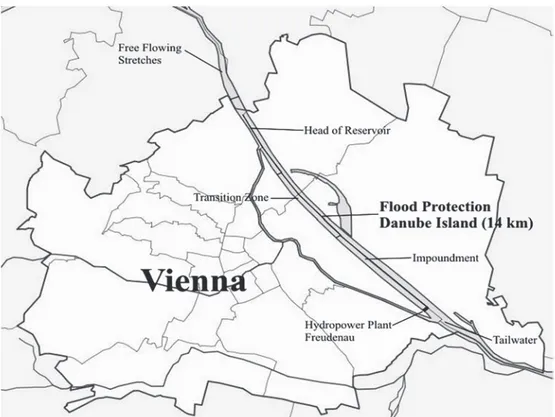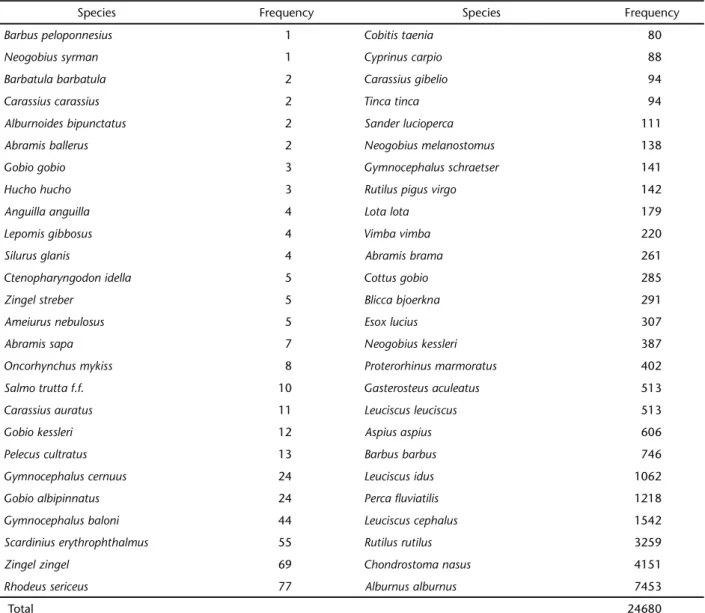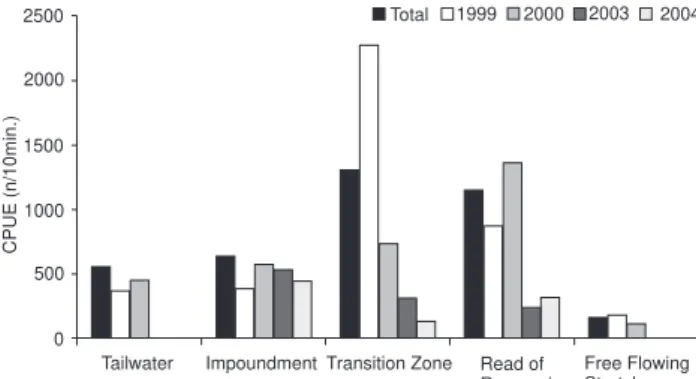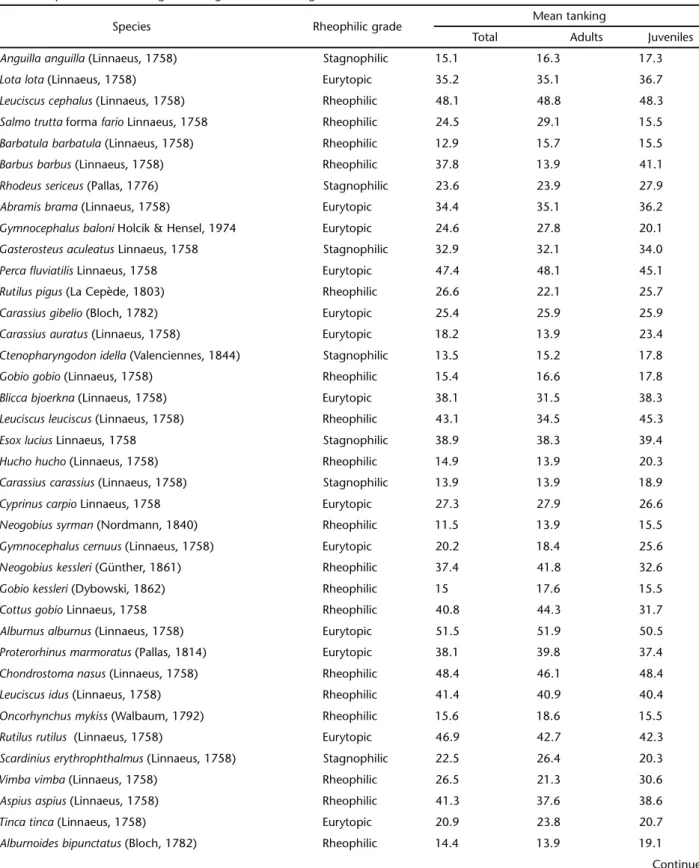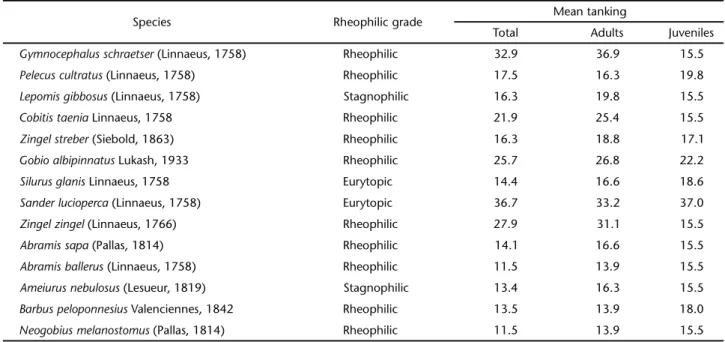In potamal rivers, hydropower plants represent special ecological problems. The low descent requires large-dimensioned impoundments. Monotonous habitats arise both in the reten-tion areas and tailwaters. Hinterland detachment and ground-water isolation impair the riparian forest. Key features include the reduction of dynamic processes, such as one-sided directional developments, which are expressed as degradation and obsoles-cence of the vegetation. The river bed erosion related to bed load retention represents another problem (JUNGWIRTH et al. 2003). Originally, the Danube in the Vienna area was a braided river system with numerous mainstreams and tributaries. The regulation in the 19th century, however, created a single river mainstream. The typical fish fauna is therefore confined to the main arm of the river. The regulation increased flow velocity and river bed erosion, leading to a dominance of rheophilic fish species (WAIDBACHER et al. 1996).
During the construction of the hydropower plant Freudenau, structures and habitats were created and a bypass channel was built according to the requirements of the Euro-pean Water Framework Directive. This was preceded by research
by the Institute of Hydrobiology and Aquatic Water Management, University for Natural Resources and Applied Life Sciences, into the ecological preservation in the area of hydro-power plant Freudenau (WAIDBACHER et al. 1996).
Both benthic long-term relationships and the fish bio-cenosis were studied. The study focused on the fish ecological conditions. Due to their various ecological requirements, fish species are excellent indicators for hydromorphological changes; this is decisive in assessing the freshwater ecology and especially the ecological functionality. Accordingly, fish are crucial indicators for continuum conditions and for habitat structures (SCHMUTZ et al. 2000).
The ecological functionality is the ability to maintain the ecological integrity between waters and the occurrence of organisms in the surrounding area, according to the natural characteristics of the respective water body type (ADMICKA et al. 1992).
This study evaluates the fish ecological functionality of anthropogenic shore structures related to the temporal gradient at the hydropower plant Freudenau.
Assessment of the ecological functionality of anthropogenically created
habitats in the impoundment of the hydropower plant Freudenau
(Vienna, Austria) with bi- and multivariate statistical analyses
Martin Tarkus
1; Christian Volkmann
1; Silke-Silvia Drexler
2; Herwig Waidbacher
2& Michael Straif
21 Postgraduate program of Applied Hydrobiology and Bioengeneering, Institute of Hydrobiology and Aquatic Ecosystem
Management, University of Natural Resources and Applied Life Sciences, Vienna. Max – Emanuel-Strasse 17, 1180 Wien, Austria. E-mail: martin.tarkus@gmail.com; utgard@gmx.at
2 Institute of Hydrobiology and Aquatic Ecosystem Management, University of Natural Resources and Applied Life Sciences,
Vienna. Max – Emanuel-Strasse 17, 1180 Wien, Austria. E-mail: silke.drexler@boku.ac.at; herwig.waidbacher@boku.ac.at; mstraif@spss.com
ABSTRACT. The construction of the hydropower plant Freudenau was accompanied by the introduction of new struc-tures and habitats. This study processes and evaluates the ecological fish data for the periods 1999/2000 and 2003/ 2004. The area was subdivided into five sections and 19 habitats (stream kilometer 1914.50 to 1994.60). Bi- and multivariate analyses were inducted with SPSS© (SPSS 2007). The CPUE values show that most fish remain in the Tran-sition Zone and in the Head of Reservoir. The cluster analyses of the individual habitats show that these can be charac-terized primarily by abiotic factors. There was a strong statistical relationship between the individual habitats and the Danube mainstream. We conclude that fish have access to the habitats and that there is interconnectivity between these habitats. In general, the habitats were highly accepted by the fish species: all contained both juvenile and adult fish. The differentiated spectrum of species points to complex relationships. In principle the newly created habitats can be con-sidered to be good replacement environments.
MATERIAL AND METHODS
The hydropower plant Freudenau, built between 1992 and 1998, was the first large, modern power plant ever built in a major city. For a detailed investigation, the study area (stream kilometer 1914.50 to 1994.60) was divided into five sections (GINZLER 2002). Each section contains various habitat structures located on the left river side. The five river sections are: Tailwater (strkm. 1914.50 to 1921.05), Impoundment (strkm. 1921.05 to 1928.00), Transition Zone (strkm. 1928.00 to 1935.00), Head of Reservoir (strkm. 1935.00 to 1945.50) and Free Flowing Stretches (strkm. 1945.50) (Fig. 1).
During the construction of the power plant, nine artifi-cial habitats (A-I) were installed on the left river bank to simu-late tributaries and bays. Habitat A (strkm. 1921.90 to strkm. 1922.40), B (strkm. 1923.90 to strkm. 1924.50), C (strkm. 1926.20 to strkm. 1926.70) and D (strkm. 1927.35 to strkm. 1927.50) are situated in the Impoundment. The Transition Zone encompasses habitats E (strkm. 1928.80 to strkm. 1928.90), F (strkm. 1929.90 to strkm. 1930.10) and G (strkm. 1930.90 to strkm. 1931.10). The Head of Reservoir is characterized by the habitat H (strkm. 1932.20 to strkm. 1932.50) and I (strkm. 1934.80 to strkm. 1935.50).
E-fishing creates an electric, externally applied DC field in the water to which fish react. Individuals in the electric field lines actively swim to the anode and are narcotized (electrotype narcosis). The efficiency and domain of this method depend on the conductivity of the water. E-fishing is a quantitative and species-selective fishing technique (COWX & LAMARQUE 1990). The captured fish were determined on the spot, measured and weighed. Those individuals that could not be determined (primarily juveniles) were fixed in a 4% formalin solution and later examined under a stereomicroscope. In most cases the sam-pling unit of the “CPUE” (Catch Per Unit Effort) was determined by the number of individuals per ten minutes of fishing.
The fish ecological data from 1999 to 2000 as well as from 2003 to 2004 were processed, evaluated and analyzed with multivariate statistical methods.
The data collected formed the Access databases “Freudenau” (1999/2000) and “FIDON” (2003/2004) of the Institute for Hydrobiology and Aquatic Ecosystem Manage-ment. They were further subjected to bi- and multivariate analy-ses and their temporal course evaluated. The E-fishing data were used to obtain values for an efficient statistical evaluation with binary data, frequencies and ”Catch Per Unit Effort” (CPUE). SPSS 16.0 was used for the bi- and multivariate analyses.
Hierarchical cluster analyses were conducted. The Ward method was used as a cluster method and the squared euclid-ean distance was chosen as a measure of the standard interval. Discriminant analysis was used to check the clusters.
After the cluster analyses, the mean average values of the frequencies and binary data of the fish were compared with each other to visualize the arrangement of the fish species in the partial clusters
The formation of rankings enabled an optimal compari-son, which was illustrated graphically with regard to the fre-quencies of the juvenile and adult fish. The rank variance analy-sis was carried out using the Friedman test; the coefficient of concordance was calculated with the Kendall-W test.
RESULTS
From April 1999 to November 2000 and from July 2003 to October 2004, a total of 24,680 individuals of 52 species were caught by E-fishing in the study area (Tab. I). The most frequent species were Bleak, Alburnus alburnus (Linnaeus, 1758); Nase, Chondrostoma nasus (Linnaeus, 1758); and Roach, Rutilus rutilus (Linnaeus, 1758). The rarest species were Mediterranean Barbel, Barbus peloponnesius Valenciennes, 1842; Stone Loach, Barbatula barbatula (Linnaeus, 1758); and Spirlin, Alburnoides bipunctatus (Bloch, 1782).
Most fish were caught in the Transition Zone and Head of Reservoir (Fig. 2), the fewest in the Free Flowing Stretches.
Table I. Fish frequencies at the study site, Danube River, Vienna, Austria.
Species Frequency Species Frequency
Barbus peloponnesius 1 Cobitis taenia 80
Neogobius syrman 1 Cyprinus carpio 88
Barbatula barbatula 2 Carassius gibelio 94
Carassius carassius 2 Tinca tinca 94
Alburnoides bipunctatus 2 Sander lucioperca 111
Abramis ballerus 2 Neogobius melanostomus 138
Gobio gobio 3 Gymnocephalus schraetser 141
Hucho hucho 3 Rutilus pigus virgo 142
Anguilla anguilla 4 Lota lota 179
Lepomis gibbosus 4 Vimba vimba 220
Silurus glanis 4 Abramis brama 261
Ctenopharyngodon idella 5 Cottus gobio 285
Zingel streber 5 Blicca bjoerkna 291
Ameiurus nebulosus 5 Esox lucius 307
Abramis sapa 7 Neogobius kessleri 387
Oncorhynchus mykiss 8 Proterorhinus marmoratus 402
Salmo trutta f.f. 10 Gasterosteus aculeatus 513
Carassius auratus 11 Leuciscus leuciscus 513
Gobio kessleri 12 Aspius aspius 606
Pelecus cultratus 13 Barbus barbus 746
Gymnocephalus cernuus 24 Leuciscus idus 1062
Gobio albipinnatus 24 Perca fluviatilis 1218
Gymnocephalus baloni 44 Leuciscus cephalus 1542
Scardinius erythrophthalmus 55 Rutilus rutilus 3259
Zingel zingel 69 Chondrostoma nasus 4151
Rhodeus sericeus 77 Alburnus alburnus 7453
After calculating the CPUE values of the guilds, the for-mation of the median confirmed a dominance of euryoecious species in the Impoundment and Transition Zone. The rheophi-lic and euryoecious species in Tailwater, Transition Zone and in the Free Flowing Stretches occurred in similar numbers. For the cluster analysis (Fig. 3) the pooled habitats were used as cases and the fish frequencies as variables. The cases are such that they enable the pooled habitats to be compared with the re-spective Danube mainstream section. The partial cluster 1 in-dicates connectivity between the habitats in the Impoundment, the Danube mainstream in the Impoundment and the habi-tats in the Transition Zone. A close relation is present between the Danube Transition Zone and the Danube Free Flowing Stretches in partial cluster 2. The third partial cluster demon-strates a connectivity between the habitats and the Danube mainstream in the Head of Reservoir as well the Tailwater.
The rankings (Tab. II) determine and illustrate the com-parison of the frequencies of juvenile and adult fish. In Barbel, Barbus barbus (Linnaeus, 1758); Schraetzer, Gymnocephalus schraetser (Linnaeus, 1758); and Zingel, Zingel zingel (Linnaeus, 1766), clear divergences are evident.
DISCUSSION
Previous evaluation of the last years showed 62 species in the Austrian Danube (ZWEIMÜLLER et al. 2000), where by 52 of those are autochthonous (SCHIEMER & WAIDBACHER 1998). The Danube River is a migration pathway for Ponto-Caspian fauna as well as for neobiota from the Black Sea and therefore fea-tures a high biodiversity. In addition, some fish species, e.g. Danube Roach, Rutilus pigus virgo (Heckel, 1852); Zingel, Zingel zingel (Linnaeus 1766); or White Finned Gudgeon, Gobio albipinnatus Lukash, 1933 are endemic to the Danube river basin. Historical fish data show that the present fish spectrum corresponds to the original one for most of the Danube River (JUNGWIRTH 1975).
The power plant construction and the habitat changes have apparently affected the biocenosis. The migra-tion was stopped for species like the Sterlet, Acipenser ruthenus Linnaeus, 1758. Others like the Common Minnow, Phoxinus phoxinus (Linnaeus, 1758), and Volga Zander, Sander volgensis (Gmelin, 1788) now find appropriate framework conditions for reproduction. Anadromous species, such as Acipenseridae (real sturgeons), have disappeared due to structural obstacles (e.g. dam “Iron Gate”) and overfishing in the Austrian Danube (JUNGWIRTHet al. 2003). This pertains especially to the Beluga, Huso huso (Linnaeus, 1758), and Ship Sturgeon, Acipenser nudiventris Lovetzk, 1828.
The reduced flow velocity, altered sedimentation and dominance of ripraps promoted the successful settlement of stable populations of stagnophilic and of alien species. The abundant fish in the Transition Zone and Head of Reservoir can be explained by the better framework conditions with re-spect to food supply and reproduction spaces. The abiotic fac-tors create excellent conditions (varying flow velocities) and structural variety for the fish biocenosis.
An analysis of the fish species and guilds shows that euryoecious types dominate the spectrum. The Impoundment contains a wide range (39) of fish species. The reduced flow
2500 2000 1500 1000 500 0 CPUE (n/10min.)
Tailwater Impoundment Transition Zone Read of
Reservoir
Free Flowing Stretches
Total 1999 2000 2003 2004
Figure 2. Fish frequency based on CPUE in each section of the investigation area.
0 5 10 15 20 25
Rescaled Distance Cluster Combine
C A S E
Num Label 2 4 3 5 8 1 7 6 Habitat_A_D Habitat_E_G Habitat_H_I Donau_A_D Donau_E_G Donau__FF Donau_UW Donau_H_I
Table II. Compared Mean Rankings of fish ages. Greater divergences are marked.
Species Rheophilic grade Mean tanking
Total Adults Juveniles
Anguillaanguilla (Linnaeus, 1758) Stagnophilic 15.1 16.3 17.3 Lotalota (Linnaeus, 1758) Eurytopic 35.2 35.1 36.7 Leuciscuscephalus (Linnaeus, 1758) Rheophilic 48.1 48.8 48.3 Salmotrutta forma fario Linnaeus, 1758 Rheophilic 24.5 29.1 15.5 Barbatulabarbatula (Linnaeus, 1758) Rheophilic 12.9 15.7 15.5 Barbusbarbus (Linnaeus, 1758) Rheophilic 37.8 13.9 41.1 Rhodeussericeus (Pallas, 1776) Stagnophilic 23.6 23.9 27.9 Abramisbrama (Linnaeus, 1758) Eurytopic 34.4 35.1 36.2 Gymnocephalusbaloni Holcik & Hensel, 1974 Eurytopic 24.6 27.8 20.1 Gasterosteusaculeatus Linnaeus, 1758 Stagnophilic 32.9 32.1 34.0 Percafluviatilis Linnaeus, 1758 Eurytopic 47.4 48.1 45.1 Rutiluspigus (La Cepède, 1803) Rheophilic 26.6 22.1 25.7 Carassiusgibelio (Bloch, 1782) Eurytopic 25.4 25.9 25.9 Carassiusauratus (Linnaeus, 1758) Eurytopic 18.2 13.9 23.4 Ctenopharyngodonidella (Valenciennes, 1844) Stagnophilic 13.5 15.2 17.8
Gobiogobio (Linnaeus, 1758) Rheophilic 15.4 16.6 17.8
Bliccabjoerkna (Linnaeus, 1758) Eurytopic 38.1 31.5 38.3 Leuciscusleuciscus (Linnaeus, 1758) Rheophilic 43.1 34.5 45.3
Esoxlucius Linnaeus, 1758 Stagnophilic 38.9 38.3 39.4
Huchohucho (Linnaeus, 1758) Rheophilic 14.9 13.9 20.3
Carassiuscarassius (Linnaeus, 1758) Stagnophilic 13.9 13.9 18.9 Cyprinuscarpio Linnaeus, 1758 Eurytopic 27.3 27.9 26.6 Neogobiussyrman (Nordmann, 1840) Rheophilic 11.5 13.9 15.5 Gymnocephaluscernuus (Linnaeus, 1758) Eurytopic 20.2 18.4 25.6 Neogobiuskessleri (Günther, 1861) Rheophilic 37.4 41.8 32.6 Gobiokessleri (Dybowski, 1862) Rheophilic 15 17.6 15.5
Cottusgobio Linnaeus, 1758 Rheophilic 40.8 44.3 31.7
Alburnusalburnus (Linnaeus, 1758) Eurytopic 51.5 51.9 50.5 Proterorhinusmarmoratus (Pallas, 1814) Eurytopic 38.1 39.8 37.4 Chondrostomanasus (Linnaeus, 1758) Rheophilic 48.4 46.1 48.4 Leuciscusidus (Linnaeus, 1758) Rheophilic 41.4 40.9 40.4 Oncorhynchusmykiss (Walbaum, 1792) Rheophilic 15.6 18.6 15.5 Rutilusrutilus (Linnaeus, 1758) Eurytopic 46.9 42.7 42.3 Scardiniuserythrophthalmus (Linnaeus, 1758) Stagnophilic 22.5 26.4 20.3
Vimbavimba (Linnaeus, 1758) Rheophilic 26.5 21.3 30.6
Aspiusaspius (Linnaeus, 1758) Rheophilic 41.3 37.6 38.6
Tincatinca (Linnaeus, 1758) Eurytopic 20.9 23.8 20.7
Table II. Continued.
Species Rheophilic grade Mean tanking
Total Adults Juveniles
Gymnocephalusschraetser (Linnaeus, 1758) Rheophilic 32.9 36.9 15.5 Pelecuscultratus (Linnaeus, 1758) Rheophilic 17.5 16.3 19.8 Lepomisgibbosus (Linnaeus, 1758) Stagnophilic 16.3 19.8 15.5
Cobitistaenia Linnaeus, 1758 Rheophilic 21.9 25.4 15.5
Zingelstreber (Siebold, 1863) Rheophilic 16.3 18.8 17.1
Gobioalbipinnatus Lukash, 1933 Rheophilic 25.7 26.8 22.2
Silurusglanis Linnaeus, 1758 Eurytopic 14.4 16.6 18.6
Sanderlucioperca (Linnaeus, 1758) Eurytopic 36.7 33.2 37.0
Zingelzingel (Linnaeus, 1766) Rheophilic 27.9 31.1 15.5
Abramissapa (Pallas, 1814) Rheophilic 14.1 16.6 15.5
Abramisballerus (Linnaeus, 1758) Rheophilic 11.5 13.9 15.5 Ameiurusnebulosus (Lesueur, 1819) Stagnophilic 13.4 16.3 15.5 Barbuspeloponnesius Valenciennes, 1842 Rheophilic 13.5 13.9 18.0 Neogobiusmelanostomus (Pallas, 1814) Rheophilic 11.5 13.9 15.5
velocity after the power plant construction shifted the rheophilic ichthyofauna to a stagnophilic and euryoecious guild membership.
Currently, 33 of the 52 recorded species at the study site are found in the immediate Tailwater (without riparian forest). This may also reflect reduced predator pressure as well as com-pensation and spawn migration. The fewest species were found in the Free Flowing Stretches; they mainly represent rheophilic forms.
In principle, stagnophilic-euryoecious species dominate the Impoundment and the Transition Zone. The Head of Res-ervoir and the Free Flowing Stretches are preferred by rheophilic fish.
This study confirmed the acceptance of habitats by fish species. The statistical analyses, such as the cluster analyses with pooled habitats, demonstrated connectivity between the habitats and the Danube mainstream. The partial cluster 1 (Fig. 3) can be summarized by flow velocity and includes stagnophilic and euryoecious species. The connection in partial cluster 2 can be explained by migration of rheophilic species to the Tran-sition Zone. The factors food, reproduction and flow velocity equally explain the third partial cluster.
At the present time the anthropogenically created habi-tats represent good replacements. Nevertheless, these habihabi-tats will never have the full quality of a natural, persistent aquatic ecosystem. This explains the great difference compared with the original spectrum of fish species, despite the high acceptance and functionality.
The construction of hydropower plants drastically changes
the natural structure and in consequence impairs the fauna, flora and the hydrologic conditions. Anthropogenically created habi-tats are limited substitutes for natural environments. This calls for further examinations and a monitoring program to better describe and understand this aquatic ecosystem.
ACKNOWLEDGEMENTS
To the initiators: European Union (EFRE), Water Man-agement magistrate of Vienna (MA 45), Austrian Federal Min-istry of Science and Research, Office of Lower Austrian Gov-ernment (NÖ Landschaftsfonds) and VERBUND Austrian Hy-dro Power. To all dear colleagues from the Institute of HyHy-drobi- Hydrobi-ology and Aquatic Ecosystem Management, BOKU Vienna for the data sources and for support in the analyses; to E. Lautsch for special database instruction in the statistical analysis soft-ware; to F. Stauffer for suggestions on the manuscript.
LITERATURE CITED
ADMICKA, P.; G. BRETSCHKO; E. DANECKER; J. HINTEREGGER; G. IMHOF; M. JUNGWIRTH; M. LEICHTFRIED; O. MOOG; C. MORITZ; G. MÜLLER; R. PECHLANER; E. PIPP; E. POLZER & N. SCHULZ. 1992. Zur Gewährleistung, Beeinträchtigung und Beurteilung der ökologischen Funktionsfähigkeit von Gewässern. Österreichs Fischerei 45: 120-121.
COWX, I.G. & P. LAMARQUE. 1990. Fishing with Electricity. Fishing
New Books. Oxford, 248p.
Freudenau unter besonderer Berücksichtigung der neu geschaffenen Uferstrukturen am linken Donauufer im Bereich der Donauinsel. Wien, Universität für Bodenkultur, 149p.
JUNGWIRTH, M. 1975. Die Fischerei in Niederösterreich. Wissen-schaftliche Schriftreihe St. Pölten/Wien, Niederösterreich. NÖ Pressehaus, 31p.
JUNGWIRTH, M.; G. HAIDVOGL; O. MOOG; S. MUHAR & S. SCHMUTZ. 2003. Angewandte Fischökologie an Fließgewässern.
Wien, Facultas Universitätsverlag, 547p.
SCHIEMER, F. & H. WAIDBACHER. 1998. Zur Ökologie großer
Fließgewässer am Bespiel der Fischfauna an der österreichischen Donau. Stapfia 52, zugleich Katalog des OÖ Landesmuseums N. F. 126, p. 7-22.
SCHMUTZ, S.; M. KAUFMANN; B. VOGEL & M. JUNGWIRTH. 2000.
Methodische Grundlage und Beispiele zur Bewertung der
fischökologischen Funktionsfähigkeit österreichischer Fließgewässer. Wien, Wasserwirtschaftskataster des BMFUW, 210p.
SPSS. 2007. SPSS 16.0 für Windows. Version 16.0.1 [7.XII.2007], Copyright SPSS Inc.
WAIDBACHER, H.; G. HAIDVOGL & R. WIMMER. 1996. Beschreibung
der räumlichen und zeitlichen Verteilung der benthischen Lebensgemeinschaften und der Fischbiozönosen im Projektbereich des KW Freudenau (Limnologische Beweissicherung). Wien, Institut für Hydrobiologe und Gewässermanagement der Universität für Bodenkultur, 184p.
ZWEIMÜLLER, I.; S. GUTTMANN; G. SINGER; E-M. SCHOBER & A. WEISSENBACHER. 2000. Eine neue Fischart für Österreich – Neogobius syrman (Normann, 1940). Österreichs Fischerei 53: 186-189.
